Embedded Systems Engineer Resume Guide
Embedded Systems Engineers design and develop hardware components, software systems and applications for embedded devices. They are responsible for creating firmware that meets customer specifications, testing the performance of new designs to ensure they meet safety standards, debugging any problems in existing products or systems and providing technical support during product launches.
Your expertise in embedded systems and hardware design would be an invaluable asset to any engineering team. But hiring managers don’t know who you are yet, so you must write a resume that showcases your technical abilities and experience.
This guide will walk you through the entire process of creating a top-notch resume. We first show you a complete example and then break down what each resume section should look like.
Table of Contents
The guide is divided into sections for your convenience. You can read it from beginning to end or use the table of contents below to jump to a specific part.
Embedded Systems Engineer Resume Sample
Leonard Hodkiewicz
Embedded Systems Engineer
leonard.o.hodkiewicz@gmail.com
604-627-0649
linkedin.com/in/leonard-hodkiewicz
Summary
Seasoned embedded systems engineer with a track record of successfully developing and implementing complex embedded system projects. Experienced in C, C++ programming languages, microcontrollers (ARM & PIC), PCB design tools, assembly language and RTOS. Skilled at troubleshooting hardware issues as well as providing technical support to customers. Dedicated to delivering high-quality results on time while staying within budget constraints.
Experience
Embedded Systems Engineer, Employer A
Los Angeles, Jan 2018 – Present
- Reliably designed, developed and implemented embedded systems for a wide range of applications; reduced development cycle time by 25% while maintaining high quality standards.
- Analyzed complex system requirements and identified potential solutions to develop efficient firmware architectures that enhanced performance levels by 30%.
- Introduced innovative strategies to reduce power consumption in integrated circuits, resulting in cost savings of $7000 over the last quarter alone.
- Optimized existing code structures for better execution speed and improved software efficiency by 40%; significantly increased product reliability ratings from customers across multiple industries.
- Expedited debugging process with advanced diagnostic tools, reducing troubleshooting timescales on average by 10 hours per project completion cycle.
Embedded Systems Engineer, Employer B
Lakewood, Mar 2012 – Dec 2017
- Reduced system development costs by 15% and improved product performance by redesigning embedded systems for four major clients.
- Presented the innovative designs to software engineers, system architects, and senior managers; detailed design was implemented in two projects within 6 months of presentation.
- Monitored project progress closely by regularly conducting tests on existing/newly designed systems to ensure that all technical specifications were met or exceeded; prevented costly overruns due to errors in coding or hardware selection during this process.
- Meticulously debugged source codes using various debugging tools such as GDB while working with C++ & assembly language programs; quickly identified any flaws and optimized code efficiency significantly (by 20%).
- Facilitated communication between team members located at different locations throughout the world to create a collaborative environment where ideas could be exchanged without delay or misunderstandings via video conferencing technology.
Skills
- C/C++ Programming
- Microcontroller Programming
- Firmware Development
- Real-time Operating Systems
- Embedded Linux
- Networking Protocols
- PCB Design
- Debugging and Troubleshooting
- Analog and Digital Circuit Design
Education
Bachelor of Science in Electrical Engineering
Educational Institution XYZ
Nov 2011
Certifications
Certified Embedded Systems Engineer
Embedded Systems Certification Board
May 2017
1. Summary / Objective
Your resume summary should be a concise and compelling statement that outlines your experience in embedded systems engineering. Include any relevant certifications, such as the Embedded Systems Certification you recently obtained, as well as any specialties or accomplishments like developing an innovative solution to reduce power consumption on a project. Also mention how many years of experience you have working with embedded systems and which programming languages are most familiar to you.
Below are some resume summary examples:
Proficient embedded systems engineer with 5+ years of experience in developing and deploying products. Skilled at working on microprocessors, circuit design, debugging embedded software/hardware issues, and conducting performance optimization tests. At XYZ Corp., designed an integrated system for a client that reduced their operational cost by 20%. Adept in writing technical reports to document the findings from performance analysis.
Committed and experienced embedded systems engineer with 8+ years of experience developing and debugging software for various microprocessors. Seeking to join ABC Tech in order to utilize my expertise in ARM Cortex-M, C/C++ programming, RTOSs (FreeRTOS), electronics design & prototyping, and DSP algorithms development. Achievements include a 20% reduction in power consumption on an IoT device by optimizing the system architecture.
Detail-oriented embedded systems engineer with 8+ years of experience developing and deploying embedded software solutions. Expert in C++, Python, Linux kernel and device drivers for a variety of microprocessors. Experienced in designing PCBs using Eagle CAD/Altium Designer tools as well as debugging hardware circuits. Developed 20+ successful projects including IoT devices that are now being used by 1000+ people worldwide.
Hard-working embedded systems engineer with 8+ years of experience in developing and testing electrical components, firmware, and software. Expertise in embedded C/C++ programming, RTOS (Real-time Operating Systems), Linux kernel development, ARM Cortex processors and microcontroller architecture. At XYZ Corporation designed a low cost embedded system for industrial automation that increased production efficiency by 35%.
Talented embedded systems engineer with 8+ years of experience in designing and developing embedded software for a range of products. Seeking to join ABC Tech to leverage my knowledge in C programming, real-time operating systems, and hardware design principles. At XYZ Corporation, led the development team that reduced project timeline by 40%, while improving overall product reliability by 20%.
Energetic embedded systems engineer with 8+ years of experience in developing, testing and debugging embedded software for microprocessors. Skilled in C/C++ programming languages as well as RTOS (real-time operating system) designs. Seeking to leverage my technical skillset at ABC Tech to design innovative products that meet customer needs while staying on top of the latest industry trends.
Driven Embedded Systems Engineer with 5+ years of experience in developing and testing embedded software for medical, industrial, automotive, and consumer products. Experienced in designing hardware/software systems from concept to production using C/C++ languages. Developed real-time control algorithms for a leading manufacturer of motion controllers that increased efficiency by 15%.
Professional embedded systems engineer with 10+ years of experience developing, testing and deploying embedded products for a variety of industries. Seeking to join ABC Tech to leverage expertise in designing efficient hardware architectures and debug complex system issues. At XYZ, led the development cycle on 8 successful projects that increased sales by 25%.
2. Experience / Employment
In the experience section, you should provide details about your employment history. This section should be written in reverse chronological order, meaning the most recent role is listed first.
When writing this part of your resume, use bullet points to make it easier for the reader to digest what you have said quickly and accurately. You want to take some time thinking about the specific tasks that you did and any quantifiable results obtained from them.
For example, instead of saying “Developed embedded systems,” you could say something like “Developed an embedded system with a real-time operating system (RTOS) utilizing C++ programming language; achieved a 30% reduction in power consumption.”
To write effective bullet points, begin with a strong verb or adverb. Industry specific verbs to use are:
- Designed
- Programmed
- Implemented
- Debugged
- Tested
- Developed
- Analyzed
- Optimized
- Configured
- Monitored
- Troubleshot
- Documented
- Integrated
- Upgraded
- Deployed
Other general verbs you can use are:
- Achieved
- Advised
- Assessed
- Compiled
- Coordinated
- Demonstrated
- Expedited
- Facilitated
- Formulated
- Improved
- Introduced
- Mentored
- Participated
- Prepared
- Presented
- Reduced
- Reorganized
- Represented
- Revised
- Spearheaded
- Streamlined
- Structured
- Utilized
Below are some example bullet points:
- Substantially increased embedded system performance by 25% through the implementation of optimization strategies, such as algorithm design and software integration.
- Configured and tested over 400 microcontroller-based systems for reliable real-time operation; reduced time to market from 6 months to 3 months.
- Represented the engineering department in major client meetings, leading discussions on current projects’ technical feasibility and resource requirements while monitoring customer satisfaction levels closely.
- Deployed a total of 15+ subsystems with multiple hardware components into production environments successfully; achieved 100% product acceptance rate among users within 1 month post-launch phase.
- Designed advanced diagnostic programs that detected coding errors quickly, resulting in fewer defects throughout development process and reducing debugging time by 20%.
- Upgraded embedded systems for 10+ clients, leading to a 15% increase in device performance and reliability.
- Developed embedded software solutions utilizing C/C++ programming language; achieved compliance with industry standards such as MISRA-C and DO-178B.
- Troubleshot hardware & software issues related to various microcontrollers including ARM Cortex A8 processors and Atmel AT89 devices; reduced debugging time by 45%.
- Achieved cost savings of $20K over 6 months through efficient use of resources while developing firmware projects from scratch according to customer specifications.
- Diligently maintained records of all test results, code versions and system configurations throughout the product life cycle process; updated documentation regularly in order to ensure accuracy & traceability at all times.
- Consistently developed embedded systems for industrial applications, cutting development time by 40% and reducing errors in production code by 15%.
- Integrated hardware and software components to build robust embedded system architectures that met customer specifications and requirements; successfully designed 3 new products in the last 6 months.
- Demonstrated expertise with C++ programming language, Linux operating systems and microcontrollers to create innovative solutions for a variety of projects across industries such as automotive, medical device manufacturing, consumer electronics etc.
- Documented all stages of the design process from concept through implementation within engineering databases; increased accessibility of project information by 30%.
- Coordinated closely with other engineers on various tasks related to boards bring up processes & debugging tools while meeting tight deadlines every month without compromising quality standards or timelines set forth initially.
- Actively developed, tested and deployed embedded systems solutions for a variety of clients, boosting customer satisfaction by 20% in the last quarter.
- Implemented troubleshooting protocols to debug hardware & software issues with various micro-controllers used in embedded systems; reduced system downtime by 50 hours over 6 months.
- Prepared clear technical documentation outlining all design aspects of new products as well as existing models already on the market, providing detailed insight into each system’s inner workings and performance metrics.
- Debugged errors related to firmware development on dozens of embedded devices; decreased average resolution time from 3 days to 2 hours through use of advanced debugging tools & techniques such as static analysis and code coverage testing methods.
- Structured sophisticated algorithms for efficient data communication between multiple peripheral components connected within an integrated architecture framework; improved operational efficiency by 25%.
- Reorganized and upgraded embedded systems architecture, resulting in a 10% decrease in power consumption and 25% improvement in system stability.
- Utilized C++ and Python to develop software for embedded systems applications, troubleshooting issues with existing code or creating new modules as needed.
- Spearheaded the design of 12+ microcontroller-based products from scratch; coordinated development efforts among different teams while ensuring schedules were met on time & within budget constraints.
- Effectively diagnosed hardware faults across multiple platforms by utilizing debugging tools such as logic analyzers and oscilloscopes; reduced downtime associated with repairs by 50%.
- Mentored junior engineers on best practices related to embedded system engineering, including coding standards, project management methods and industry trends; provided guidance that enabled them to complete projects ahead of schedule by an average of 3 weeks per assignment.
- Revised and optimized embedded system code for 80+ products, leading to a 15% reduction in development cost and a 10% improvement in product performance.
- Advised hardware design teams on the most suitable microprocessors and memory controllers for use with specific applications; created comprehensive documentation detailing software/hardware compatibility requirements.
- Programmed digital signal processing (DSP) algorithms into microcontrollers, allowing manipulation of audio signals from various sources and generating impressive sound quality levels with minimal power consumption (+20%).
- Tested dozens of prototypes against strict safety regulations before rolling out production units; implemented additional security features that ensured operational reliability by 25%.
- Thoroughly examined existing programs to identify flaws or inconsistencies, resulting in improved functionality across 50+ systems while reducing debugging time by 20 hours per project cycle averagely.
- Assessed and evaluated system requirements, resulting in the successful development of embedded systems for 10+ projects and a reduction of 30% in cost.
- Streamlined firmware development process by introducing optimized coding techniques; improved software performance and reduced debugging time by 20%.
- Competently designed real-time operating systems architectures using hardware components such as processors, A/D converters, microcontrollers and memory devices to ensure optimal functionality.
- Participated actively in code review sessions with peers to identify any potential issues or bugs before product launch; tested over 25 functionalities on multiple platforms without any critical errors reported post-release.
- Improved overall reliability of embedded systems through automated testing processes that increased throughput from 15 programs per day up to 40+.
3. Skills
The skillset employers require in an employee will likely vary, either slightly or significantly; skimming through their job adverts is the best way to determine what each is looking for. One organization may be looking for someone with expertise in C++ and another may require knowledge of embedded systems.
It is important to tailor the skills section of your resume according to each job that you apply for, as many employers use applicant tracking systems these days which scan resumes for certain words or phrases before passing them on to a human.
You can further elaborate on the most pertinent skills by discussing them in more detail throughout other sections such as summary or experience.
Below is a list of common skills & terms:
- Analog and Digital Circuit Design
- C/C++ Programming
- Debugging and Troubleshooting
- Embedded Linux
- Embedded System Security
- Firmware Development
- Microcontroller Programming
- Networking Protocols
- PCB Design
- Real-time Operating Systems
4. Education
Including an education section on your resume will depend on how far along you are in your career. If you just graduated and have no work experience, your education should be mentioned below your resume objective. However, if you have significant work experience to showcase, omitting the education section is perfectly fine.
If an education section is included, try to mention courses and subjects related to embedded systems engineering that demonstrate a strong understanding of the job requirements.
Bachelor of Science in Electrical Engineering
Educational Institution XYZ
Nov 2011
5. Certifications
Certifications demonstrate to potential employers that you have the knowledge and skills necessary for a given job. They also show that you are committed to staying up-to-date with industry trends and developments, which can be highly beneficial in competitive fields.
If there is an applicable certification related to the position you’re applying for, make sure it is included on your resume so hiring managers know what qualifications you possess.
Certified Embedded Systems Engineer
Embedded Systems Certification Board
May 2017
6. Contact Info
Your name should be the first thing a reader sees when viewing your resume, so ensure its positioning is prominent. Your phone number should be written in the most commonly used format in your country/city/state, and your email address should be professional.
You can also choose to include a link to your LinkedIn profile, personal website, or other online platforms relevant to your industry.
Finally, name your resume file appropriately to help hiring managers; for Leonard Hodkiewicz, this would be Leonard-Hodkiewicz-resume.pdf or Leonard-Hodkiewicz-resume.docx.
7. Cover Letter
A cover letter is an essential document for job applications. It is separate from your resume and typically composed of 2 to 4 paragraphs. Its purpose is to provide additional information about yourself that isn’t mentioned in the curriculum vitae and allow you to explain why you’re a great fit for the role.
Writing a cover letter offers many advantages, even if employers don’t require it as part of their application process. Doing so gives recruiters further insights into who you are, what skills or experiences you possess, and how they can benefit them if hired on board.
Below is an example cover letter:
Dear Favian,
I am writing to apply for the position of Embedded Systems Engineer at XYZ Corporation. With more than eight years of experience in embedded systems engineering, I possess a the comprehensive skill set and hands-on experience that will enable me to contribute significantly to your organization.
Most recently, I have been working as an embedded systems engineer at ABC Technologies, where I was responsible for designing, developing, testing, and deploying firmware for a variety of products. During my time there, I gained extensive experience with various microcontrollers and development tools, which has given me a strong foundation on which to build upon. In addition, I have also developed strong problem solving skills and a keen eye for detail that allows me to troubleshoot issues quickly and efficiently.
I am confident that I can be an asset to your team and would welcome the opportunity to put my skills and experience to work for you. If you have any questions or would like further information about my qualifications or background, please do not hesitate to contact me at [phone number] or [email address]. Thank you for your time consideration; I look forward hearing from you soon.
Sincerely,
Leonard
Embedded Systems Engineer Resume Templates
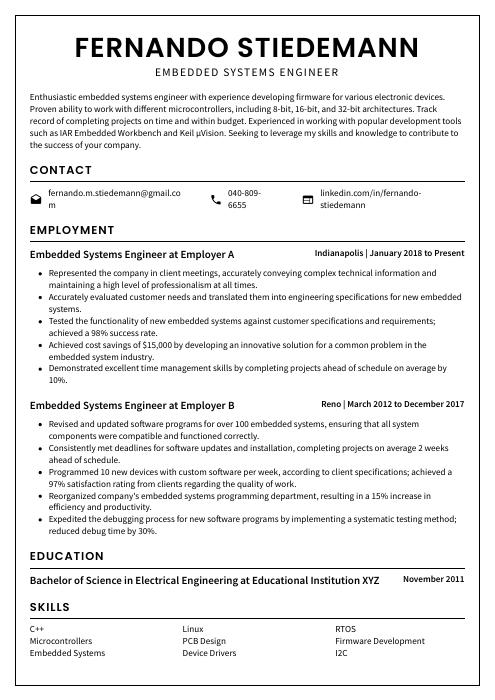 Cormorant
Cormorant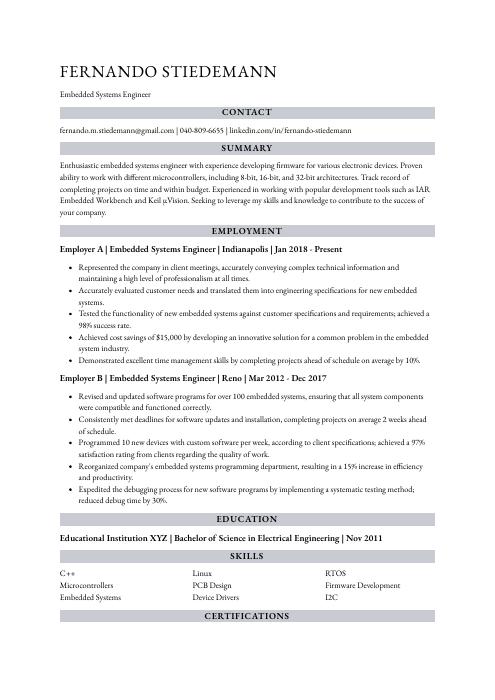 Numbat
Numbat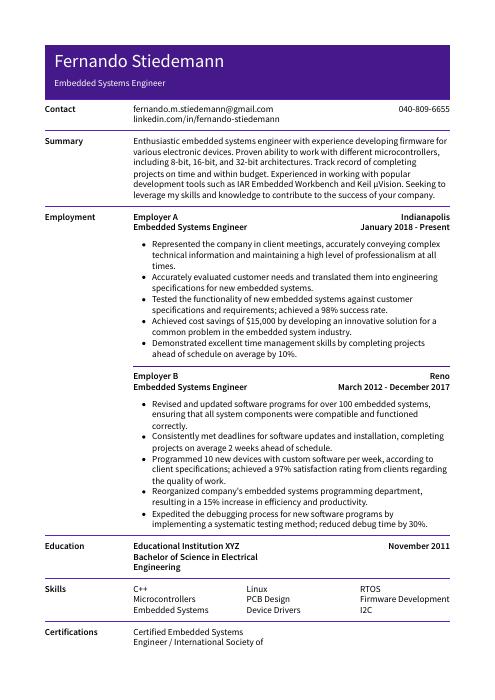 Pika
Pika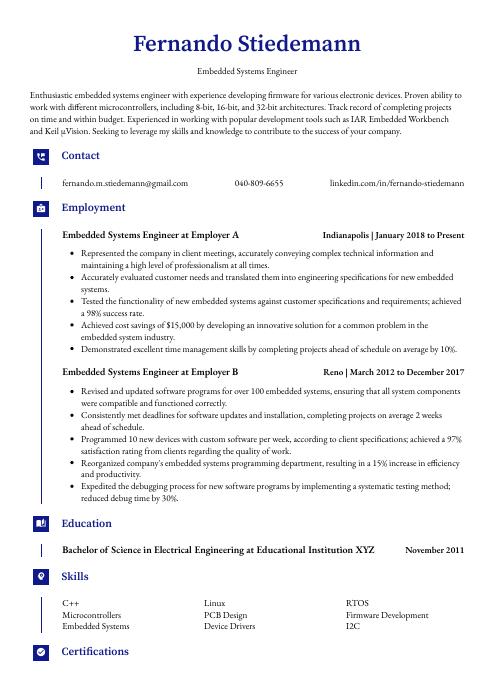 Gharial
Gharial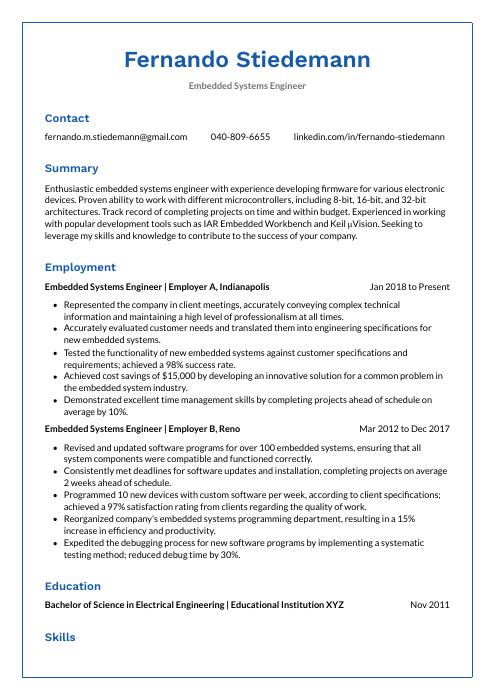 Markhor
Markhor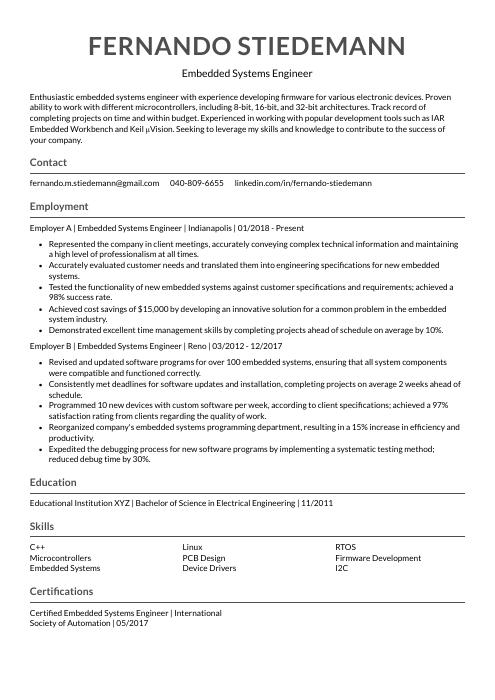 Indri
Indri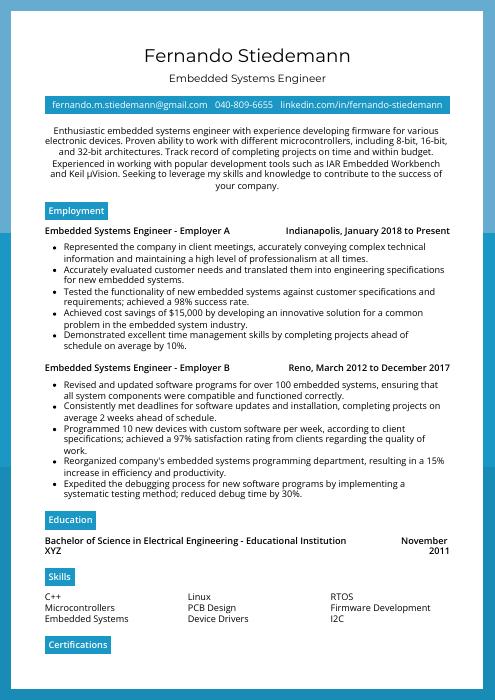 Rhea
Rhea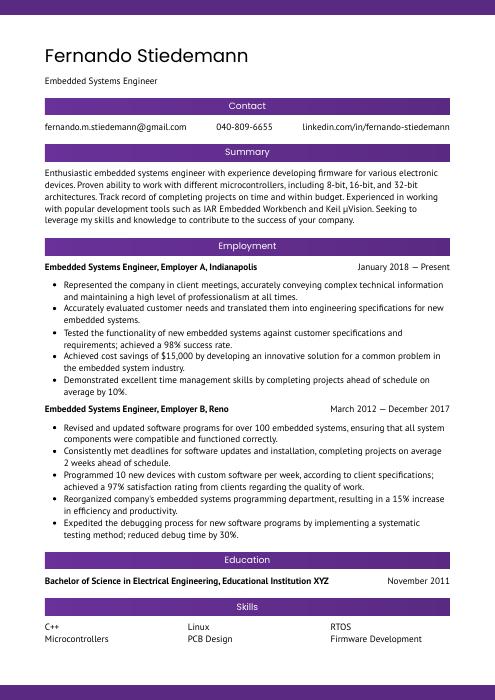 Jerboa
Jerboa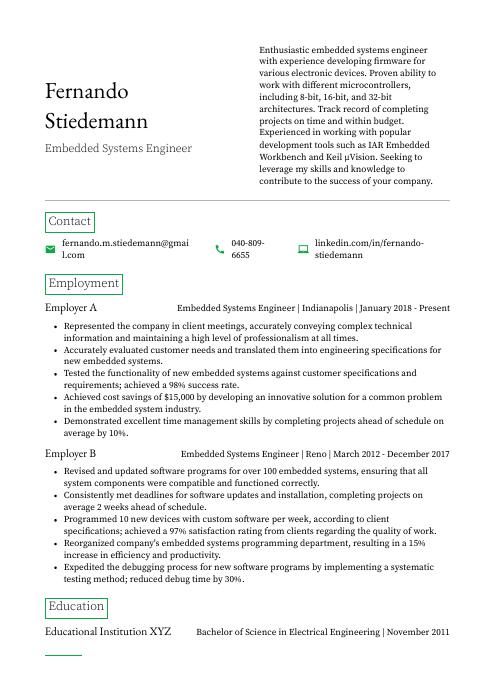 Quokka
Quokka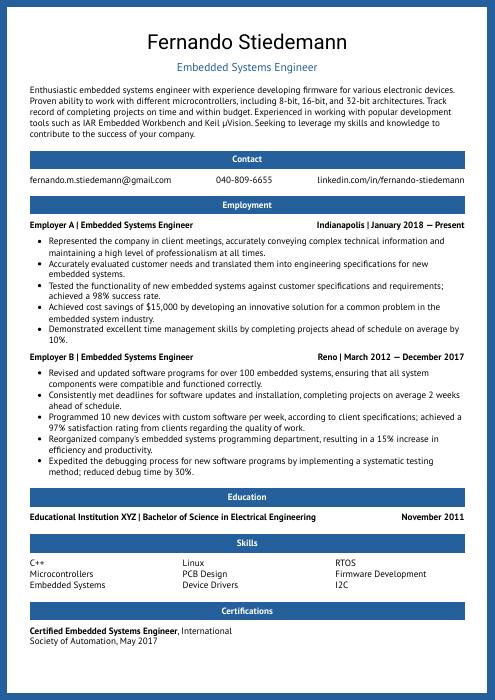 Ocelot
Ocelot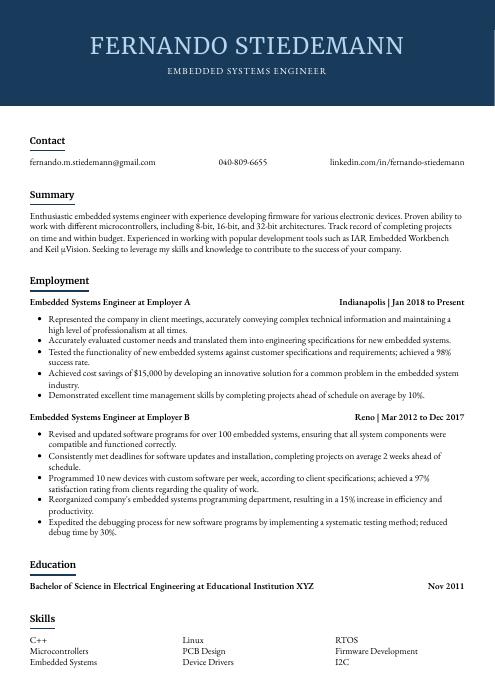 Bonobo
Bonobo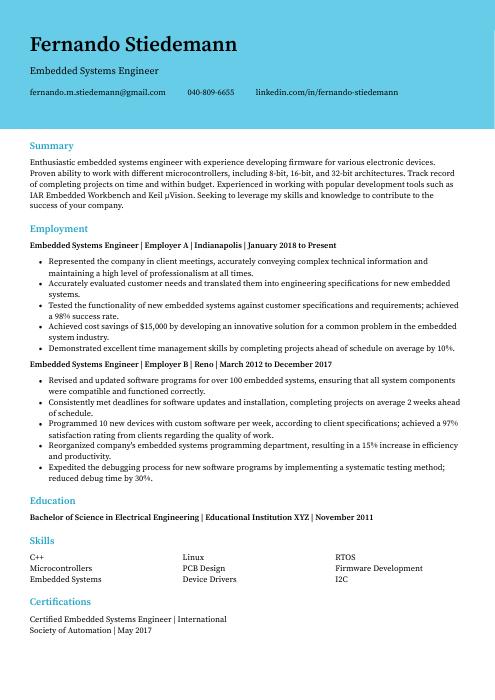 Dugong
Dugong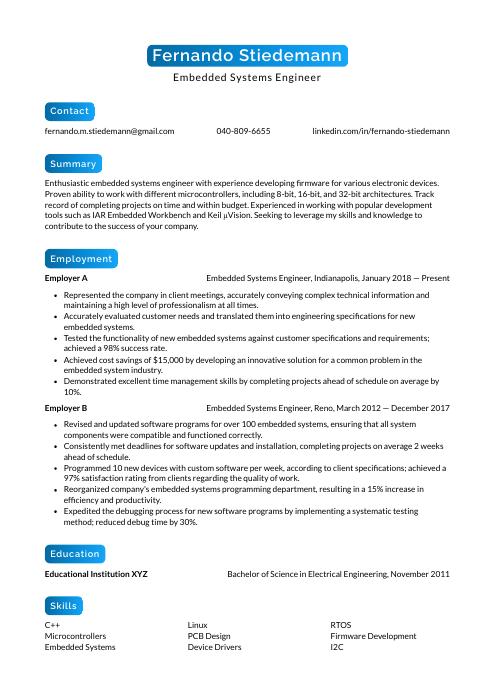 Kinkajou
Kinkajou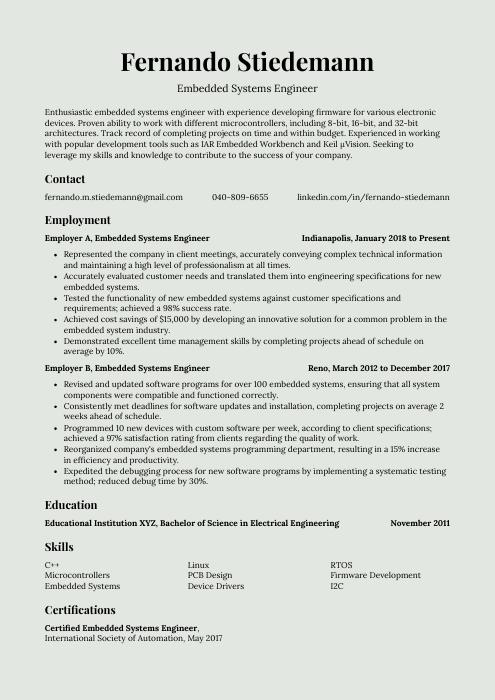 Saola
Saola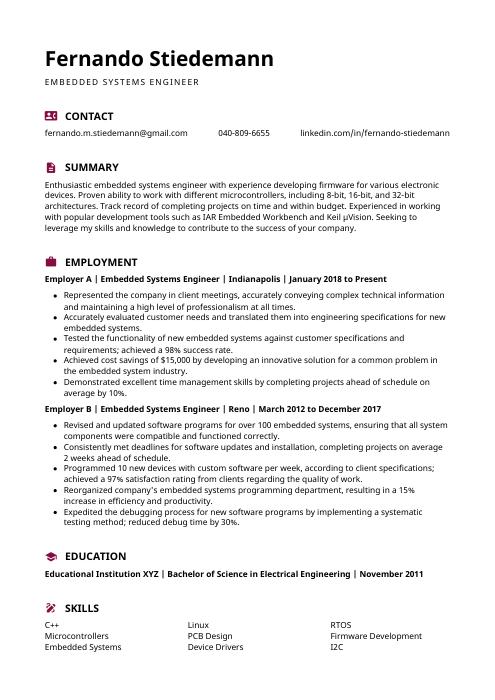 Hoopoe
Hoopoe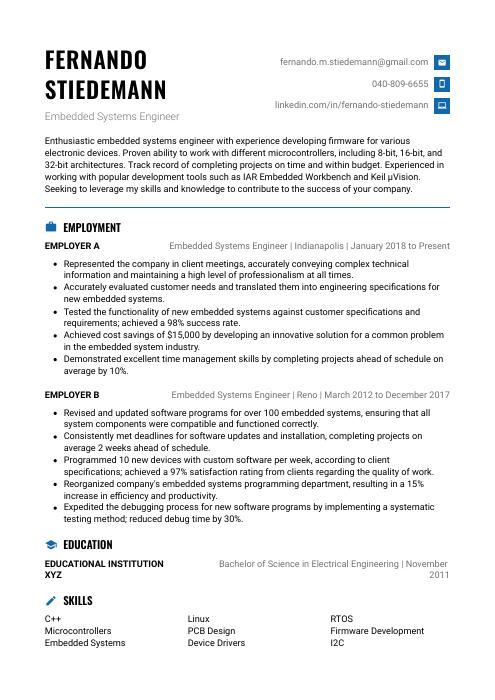 Echidna
Echidna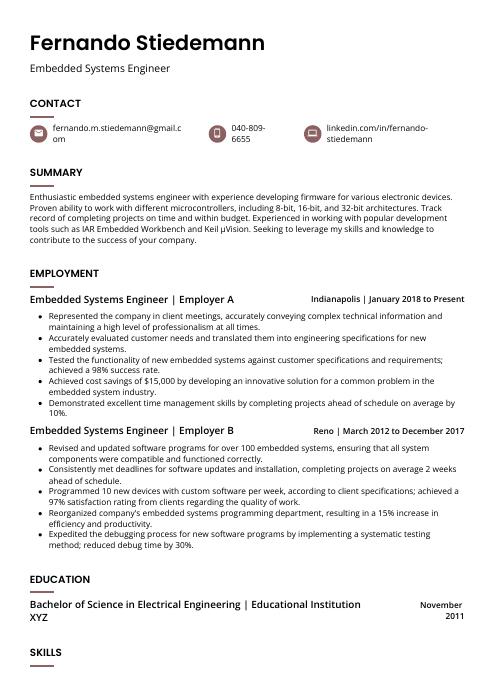 Fossa
Fossa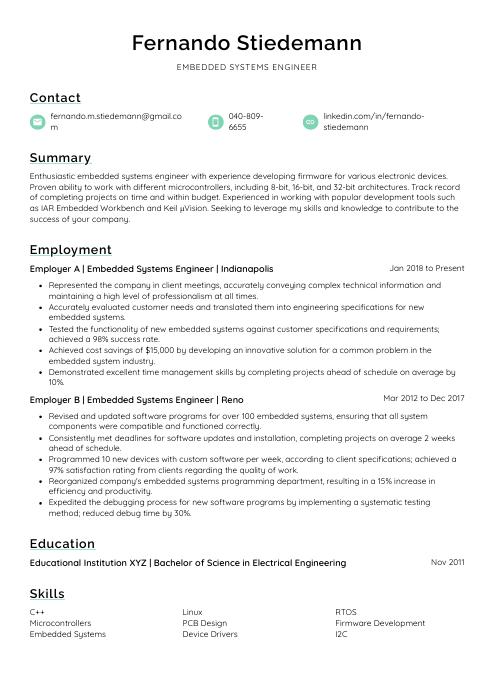 Lorikeet
Lorikeet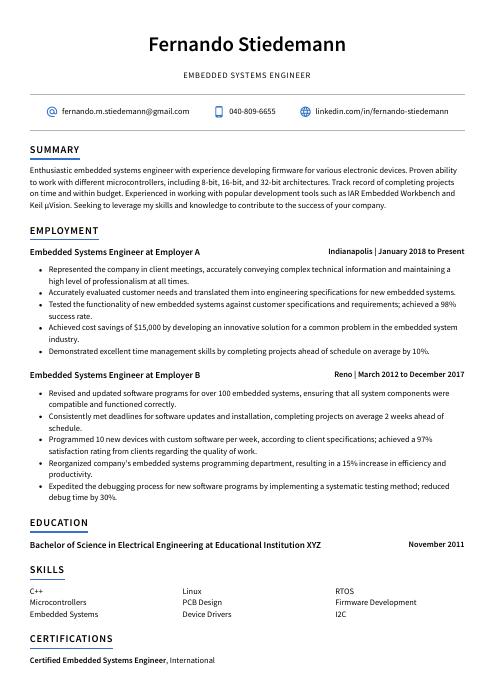 Axolotl
Axolotl Rezjumei
Rezjumei